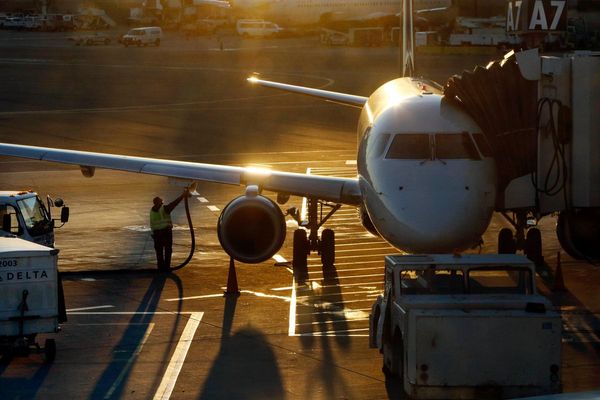On both sides of Capitol Hill, there is budding interest in implementing taxes on carbon-intensive goods that enter the U.S., though Democrats and Republicans tend to be interested for different reasons.
In the Senate, Louisiana Republican Bill Cassidy is writing a preliminary bill, expected in a few months, to place a fee on foreign products brought into the country that are made with more pollution than similar American products.
Republicans Kevin Cramer of North Dakota and Lindsey Graham of South Carolina and Democrats Sheldon Whitehouse of Rhode Island and Chris Coons of Delaware are broadly supportive of such a concept, generally called a carbon border adjustment mechanism.
And Rep. Scott Peters, D-Calif., is working on his proposal and “taking to colleagues,” said Paul Iskajyan, a spokesman.
Peters and Coons introduced legislation last Congress to implement a tax on a range of imported commodities, specifically steel, aluminum, cement, iron and the three fossil fuels: coal, oil and gas.
The uptick in congressional interest comes as the European Union, the world’s largest trading bloc, is on track to implement the first phase of a carbon border scheme in October. The policy will place fees on certain of imported goods, including iron and steel, cement, fertilizer, aluminum and electricity.
When the EU begins an initial phase of the new tax in October, importers will have to file quarterly reports about the goods they are bringing into the union, including the emissions released in the creation of the products.
In 2026, the tax will kick in and be fully implemented in 2034.
The EU’s carbon border mechanism is part of a larger set of environmental policies the 27-member bloc is pursuing, including reforms to its emissions trading market. Once the price starts in 2026, it would be charged based on the weekly prices of the EU emissions trading market, the world’s largest and first such market, started in 2005.
Republican draw
Greg Bertelsen, CEO of the Climate Leadership Council, an advocacy group that supports carbon pricing, said the origins of Republicans’ interest in carbon border adjustment tools typically stems from economic or trade reasons, while the climate upside is secondary.
For Democrats in Congress, it’s often the reverse. No matter the topic that piqued other members’ interest, the climate reduction benefits align with their agenda, Bertelsen said by phone.
“There’s not perfect overlap at this very moment,” Bertelsen said. “I think the next step in this, we’ll see probably partisan approaches, Republican approaches and Democratic approaches, and then we’ll see whether there’s overlap.”
He added: “But I think everybody who’s in this space sees that there’s a big opportunity down the road for bipartisanship.”
During a February hearing of the Senate Banking, Housing and Urban Affairs Committee, Cramer said he is interested in a carbon border mechanism because it would recognize that “carbon-intensive companies” in the U.S. already operate under higher environmental standards than foreign competitors.
Cassidy echoed similar notes during a March 23 hearing, asking Katherine Tai, the U.S. Trade Representative, about how to counter pollution from China through trade policy.
Tai and Cassidy talked the day before about his bill, which Cassidy describes as a “foreign pollution fee,” according to a spokesperson for the senator.
In a statement, a Cassidy spokesperson described the EU mechanism as “a flawed model focused on carbon pricing and domestic protection.”
“Senator Cassidy is interested in promoting the use of cleaner produced goods domestically and internationally,” the spokesperson said. “He anticipates introducing legislation that focuses on ensuring imports dirtier than American-made products are disadvantaged while including a pathway to expand the policy to international partners.”
At a Senate Finance Committee hearing last month, Tai told Whitehouse that “carbon intensity” — the volume of greenhouse gases used to make a product — is a factor in ongoing global trade negotiations on steel and aluminum.
Whitehouse outlined a scenario in which a series of countries could soon have some sort of carbon pricing and carbon border policies in place.
“The EU has announced a CBAM. They’ve pretty well defined it. It’s coming at us,” Whitehouse said, using the shorthand for the border adjustment. “I hope very much that that will be seen as a welcome step by the administration and one that we can try to meet and match. I think the EU CBAM opens the prospect of us joining into a common carbon border agreement.”
Whitehouse added: “Canada, I’m told, is eager to join. The U.K. has done the hard part, which is the carbon price. The tariff part is relatively easy. So we are within plausible reach of a carbon pricing agreement among U.K., U.S., Canada, EU, who knows, perhaps Australia.”
Rule breaker?
Under a multilateral policy that governs trade disputes called the General Agreement on Tariffs and Trade, countries can’t treat imports differently than domestic products.
In other words, the costs industries have to pay on both sides of a given international border have to be even, or a country could run afoul of World Trade Organization rules.
Since the EU policy is the first of its kind, it’s unclear how the WTO would treat a potential trade violation about a carbon border adjustment mechanism, said Bertelsen.
“All of this is untested at the WTO,” he said “We don’t actually know what would and what wouldn’t withstand WTO scrutiny.”
The EU’s actions have ruffled members of Congress, as Christoph Heusgen, chairman of the Munich Security Conference, said in March, when he told Vice President Kamala Harris the 2022 climate law has stimulated some irritation in Europe, where some firms see the law as an unfair economic edge.
“It has raised a lot of concern on this side of the Atlantic,” Huesgen said. “But we have been reminded also by members of Congress about CBAM on our side.”
Lindsey Walter, director of international policy for center-left think tank Third Way’s climate and energy program, said because industrial products made in the U.S. are often made under more environmentally stringent regulations than elsewhere, the new EU policy could give American firms an edge against foreign rivals trying to enter the European market.
“The cleaner the product, the less the producer is impacted,” Walter said in an interview.
The U.S. imported about $468 billion worth of goods to the EU in 2019, according to Walter, but the new border mechanism would affect a fraction — about $1.4 billion — she said.
By forcing competition, carbon border mechanisms could be useful in lowering emissions from the industrial sector, a notoriously difficult slice of the economy, both domestically and globally, to decarbonize.
“It’s incredibly challenging to reduce industrial emissions,” Walter said, adding that greenhouse gas emissions from industry are on track to soon be the largest source of emissions in America, surpassing those from transportation and electricity generation.
Implementing the new mechanism in Europe will be intricate and complex, experts said.
“Bigger multinational corporations might have an advantage because they’re the ones that tend to lay out their decarbonization strategy,” said Shuting Pomerleau, a climate policy analyst at the Niskanen Center, a libertarian think tank. “They probably have already mapped out their emissions footprint and set a target.”
She added that smaller companies may struggle to comply.
“I think it’s honestly going to create a whole new industry just to do this, to help importers in the U.S. and also exporters,” Pomerleau said.
The post As European tax looms, a border fee draws bipartisan focus appeared first on Roll Call.







